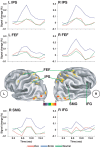An event-related functional magnetic resonance imaging study of voluntary and stimulus-driven orienting of attention
- PMID: 15872107
- PMCID: PMC6725019
- DOI: 10.1523/JNEUROSCI.0236-05.2005
An event-related functional magnetic resonance imaging study of voluntary and stimulus-driven orienting of attention
Abstract
Attention can be voluntarily directed to a location or automatically summoned to a location by a salient stimulus. We compared the effects of voluntary and stimulus-driven shifts of spatial attention on the blood oxygenation level-dependent signal in humans, using a method that separated preparatory activity related to the initial shift of attention from the subsequent activity caused by target presentation. Voluntary shifts produced greater preparatory activity than stimulus-driven shifts in the frontal eye field (FEF) and intraparietal sulcus, core regions of the dorsal frontoparietal attention network, demonstrating their special role in the voluntary control of attention. Stimulus-driven attentional shifts to salient color singletons recruited occipitotemporal regions, sensitive to color information and part of the dorsal network, including the FEF, suggesting a partly overlapping circuit for endogenous and exogenous orienting. The right temporoparietal junction (TPJ), a core region of the ventral frontoparietal attention network, was strongly modulated by stimulus-driven attentional shifts to behaviorally relevant stimuli, such as targets at unattended locations. However, the TPJ did not respond to salient, task-irrelevant color singletons, indicating that behavioral relevance is critical for TPJ modulation during stimulus-driven orienting. Finally, both ventral and dorsal regions were modulated during reorienting but significantly only by reorienting after voluntary shifts, suggesting the importance of a mismatch between expectation and sensory input.
Figures




Similar articles
-
Neural correlates of the spatial and expectancy components of endogenous and stimulus-driven orienting of attention in the Posner task.Cereb Cortex. 2010 Jul;20(7):1574-85. doi: 10.1093/cercor/bhp215. Epub 2009 Oct 21. Cereb Cortex. 2010. PMID: 19846472
-
Distinct representations of attentional control during voluntary and stimulus-driven shifts across objects and locations.Cereb Cortex. 2013 Jun;23(6):1351-61. doi: 10.1093/cercor/bhs116. Epub 2012 May 15. Cereb Cortex. 2013. PMID: 22593242
-
Interaction of stimulus-driven reorienting and expectation in ventral and dorsal frontoparietal and basal ganglia-cortical networks.J Neurosci. 2009 Apr 8;29(14):4392-407. doi: 10.1523/JNEUROSCI.5609-08.2009. J Neurosci. 2009. PMID: 19357267 Free PMC article.
-
Control of goal-directed and stimulus-driven attention in the brain.Nat Rev Neurosci. 2002 Mar;3(3):201-15. doi: 10.1038/nrn755. Nat Rev Neurosci. 2002. PMID: 11994752 Review.
-
Re-evaluating the role of TPJ in attentional control: contextual updating?Neurosci Biobehav Rev. 2013 Dec;37(10 Pt 2):2608-20. doi: 10.1016/j.neubiorev.2013.08.010. Epub 2013 Aug 30. Neurosci Biobehav Rev. 2013. PMID: 23999082 Free PMC article. Review.
Cited by
-
Auditory mismatch impairments are characterized by core neural dysfunctions in schizophrenia.Brain. 2015 May;138(Pt 5):1410-23. doi: 10.1093/brain/awv049. Epub 2015 Mar 4. Brain. 2015. PMID: 25743635 Free PMC article.
-
Contextual knowledge configures attentional control networks.J Neurosci. 2011 Dec 7;31(49):18026-35. doi: 10.1523/JNEUROSCI.4040-11.2011. J Neurosci. 2011. PMID: 22159116 Free PMC article.
-
Spatial re-orienting of visual attention along the horizontal or the vertical axis.Exp Brain Res. 2007 Jun;180(1):23-34. doi: 10.1007/s00221-006-0841-8. Epub 2007 Jan 30. Exp Brain Res. 2007. PMID: 17262217
-
Transcranial magnetic stimulation to frontal but not occipital cortex disrupts endogenous attention.Proc Natl Acad Sci U S A. 2023 Mar 7;120(10):e2219635120. doi: 10.1073/pnas.2219635120. Epub 2023 Feb 28. Proc Natl Acad Sci U S A. 2023. PMID: 36853947 Free PMC article.
-
Different effects of voluntary and involuntary attention on EEG activity in the gamma band.J Neurosci. 2007 Oct 31;27(44):11986-90. doi: 10.1523/JNEUROSCI.3092-07.2007. J Neurosci. 2007. PMID: 17978039 Free PMC article.
References
-
- Abrams RA, Dobkin RS (1994) Inhibition of return: effects of attentional cuing on eye movement latencies. J Exp Psychol Hum Percept Perform 20: 467-477. - PubMed
-
- Arrington CM, Carr TH, Mayer AR, Rao SM (2000) Neural mechanisms of visual attention: object-based selection of a region in space. J Cogn Neurosci 12: 106-117. - PubMed
-
- Astafiev SV, Stanley CM, Shulman GL, Corbetta M (2004) Visuospatial reorienting signals in the human temporo-parietal junction (TPJ) are independent of response selection. Soc Neurosci Abstr 30: 202.2. - PubMed
-
- Bartels A, Zeki S (2000) The architecture of the colour centre in the human visual brain: new results and a review. Eur J Neurosci 12: 172-193. - PubMed
Publication types
MeSH terms
Substances
Grants and funding
LinkOut - more resources
Full Text Sources
Other Literature Sources
Medical
